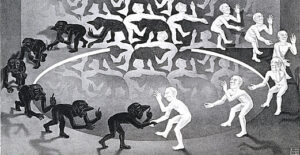I’m a little under halfway with the project of short essays that will form Part 3 of my book on humanistic psychotherapy. The next collection is entitled “with a little help from our friends”, and will consider how the humanistic practitioner might benefit from engaging with ideas from other therapeutic modalities. As a tutor on a programme centred upon cross-modality learning, I am passionate about helping trainees on both our humanistic and psychodynamic courses understand how our approaches align and differ; especially as we expand upon these ideas at MSc level as both cohorts come together on one, psychotherapy programme. It is here that some doubt and confusion can set in, as the aim of the course is NOT to produce graduates of an integrative psychotherapy but rather to invite trainees to critically engage with theories across the humanistic and psychodynamic palette – to look at one’s own approach through the lens of the other…which might lead to some sense of integration. As the opening essay in this section will explore, this integration needs to be considered carefully and critically: a selected folding in rather than wholesale mixing. I spend some time inviting consideration as to the how (making distinctions across purism, pluralism, integration, and eclecticism); as well as the where the integration takes place (at level of theory, technique, practitioner, or client).
And so here I am, another Friday…and another full day of writing ahead. I start my day here, again…in the corner of a cafe; this week with the intention is to immerse myself in the ideas of psychoanalytic and psychodynamic theory; recalling and reflecting upon my own training path and my recent teaching experiences. What are the ideas that have – and continue – to inspire me from this supposed “other side” of the therapeutic cannon? There are many, and some informal blogging time feels like an enjoyable and beneficial way to get my mind on task and dive into the dialectics of a both / and…
Distress and disturbance
The goal of the humanistic tradition is to bring online wholeness; a totality we trust is inherent, even if the various modalities under the humanistic umbrella might differ as to how much that potential might need a nudge! We might thus describe the therapeutic task as the alleviation of distress. What a study of psychoanalytic and psychodynamic theory has allowed for me is to understand more complex process of mind, one we might describe as disturbance not simply distress. This has been important to me as I know the ripples of distress feel different to the riptide of a disturbance in bodymind. Consideration of deep and intense disturbance, where a grip on consensus reality might be considered as lost, has enabled me to reformulate the rich literature base on psychosis in humanistic language. Moreover, a process-based model considers what meaning is being made through these intense experiences, and ultimately, has given me the confidence that such chronic relational deficiencies (from the past) can be healed through the present and immediate “between”.
Diagnosis and process
Undoubtedly, what can catch in the throat as humanistic practitioners get exposed to psychoanalytic ideas is the seeming lack of I-Thou when it comes to diagnosis. Psychodynamic theory has become a lot more relational and interpersonal since Freud’s initial formulation and focus on the intra-psychic; but there is value going to the far extreme to formulate such ideas through a humanistic voice. It is by studying disorders that I have become more confident in how I might word this in a process model view. Explanations of borderline personality disorder can open to rich phenomenological descriptions of adaptation, for example; equally, considering the developmental theory within narcissistic presentation has helped me lean into how that might repeatedly manifest and be worked through relationally in the room using the deeply insightful and empathic mirroring feedback developed by Masterson.
Unconscious and awareness

In the book’s early chapters, I have spent some time describing how the two traditions have different origin stories. Rather than a trainee getting preoccupied on translations of psychodynamic concepts into their own language, I encourage trainees to find peace – as humanistic practitioners we can leave well alone: our model doesn’t need an unconscious – because it is based on phenomenology and not hermeneutics. Our psychodynamic colleagues have a model of mind that uses interpretation in order for unconscious meanings to be extracted. The humanistic model of mind however pivots on an epistemology of nothing happening outside of our knowing, and thus it is through the act of description and bringing what is being known in experience to the fore that a client makes meaning. Consider Iain McGilchrist’s differential metaphor: psychodynamic practitioners are considering ‘What is under the stage’ whilst we are curious about ‘What is outside of the spotlights’ – we are working on two different dimensions.
Ego and self
Ken Wilber’s integral theory helped me consider where each therapeutic model “aimed” in the context of dissolving boundaries. As a transpersonal informed practitioner, I can start from a fundamental ground of non-separation (or intra-connection). Wilber would argue that from this source (or universal consciousness) we tend to boundary experience: so that we become separate from world, separate from our body, and separate within the mind. Transpersonal approaches work on that first separation; the humanistic on the second (bringing wholeness of bodymind and self); and the psychodynamic on the latter (making unconscious, conscious).
Mind-ing and know-ing
Peter Fonagy’s mentalisation theory has been incredibly insightful when it came to considering ‘the ability to understand the thoughts and feelings of others by imagining their inner experiences’ and the power this theory of mind affords between session holding of client process; I would add in this same regard, incorporating a faith (through Bion’s theories) in the receptive, including presence of the therapist (his alpha function) that both stimulates and processes the client’s sensory experiences (the beta elements).
The more embodied my mind has become (cf to the dissolution of the boundary between mind and body, see above), I make sense of this through the humanistic frame as the presence-to and knowing-of a client in my experience is healing. Knowing, on this scale, is a radical act that is both palpable and moving.
Personal and trans-personal
 As I start writing to this couplet, I bring to mind one particular Escher painting – the white and black beings that meet and shift to Other. It is as if the further I go in one direction, I go out, return, and meet. Whilst Freud and Jung fell out over the latter’s adoption of mystical and transpersonal features of mind, the more we explore the depth of our personal realm, the less separate we find ourselves to be. Similarly, the more I have dived into the analytical approach of Jung (and similarly, Bion) I have come to appreciate the interplay of analytic theory and the transpersonal. Jung has been a bridging function to me many times in my therapeutic career: across psychoanalytic to humanistic; from therapeutic to Buddhistic in this regard for me.
As I start writing to this couplet, I bring to mind one particular Escher painting – the white and black beings that meet and shift to Other. It is as if the further I go in one direction, I go out, return, and meet. Whilst Freud and Jung fell out over the latter’s adoption of mystical and transpersonal features of mind, the more we explore the depth of our personal realm, the less separate we find ourselves to be. Similarly, the more I have dived into the analytical approach of Jung (and similarly, Bion) I have come to appreciate the interplay of analytic theory and the transpersonal. Jung has been a bridging function to me many times in my therapeutic career: across psychoanalytic to humanistic; from therapeutic to Buddhistic in this regard for me.
Masculine and Feminine
More kudos to Jung…visiting his ideas on the collective unconscious and archetypal energies of animus / anima has helped me appreciate all the aspects and forces that might need balancing in order to stretch into our wholeness. I might even go as far as saying it is Jung that sparked my consideration of the humanistic tradition as one based on dialectics. As much a personal transmutation as an influence on my theoretical formulations, Jung’s paralleling individuation with alchemy has also helped me deepen and expand my understanding of actualisation as a journey from self to Self.
Transference and transubjective
Again, I spend a lot of time in earlier chapters of the book describing the fundamental differences across models as manifesting from different origin stories. The way self, other, relationship come into being is kind of ‘upside down’ in our two traditions: the psychodynamic model contends that self and other form relationship – and historic relationships can be ‘transferred’ from past to present. I learnt a lot about the texture of these transferential and counter-transferential dynamics (particularly in the ideas of Racker and differentiating between concordant and complementary transference). The more I have held these theories in mind, the more I have been able to make sense in my own mind and experiences how the humanistic (and I would say particularly those with the deep phenomenological stance) place interaction first. From the view of intraconnection, we start as embedded in the world, and from that inter-being we manifest as selves. Gendlin (1966) points to this as “interaction first”; and Iain McGilchrist too in his declaration, “relationships are primary, more foundational than the things related”. Thus, we are not transferring from self to self; the two selves fall from the relating itself.
I hope this blog brainstorm gives you a sense of where I am going in this section of my book. Too often the humanistic tradition gets allied with integrative therapies: and some of my mission is to define humanistic practice more precisely and as a standalone lens. While it IS fair to say many humanistic practitioners DO lend the developmental models within the psychodynamic theory of mind, we don’t need to borrow anything else – it is a complete approach itself.
My job now is to tidy this up and edit it down. So far, most of my ‘short’ essays are anything but! I look forward to presenting more of my ideas and sharing my progress with you next week. Stay tuned!
—————————
Gendlin, E.T. (1966). “Existentialism and Experiential Psychotherapy,” In Existential Child Therapy. Moustakes, C. (Ed.), Basic Books.
McGilchrist, I. (2021). The Matter with Things: Our Brains, Our Delusions, and the Unmaking of the World. Perspectiva Press.
Racker, H. (1957). The Meaning and Uses of Countertransference. Psa.Q., 26: 303-357.
Featured image thanks to www.freepik.com

